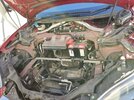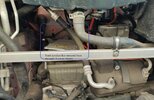yes, the fuse was blown in the front DC Junction box as well. It was not easy to get to from front as it's is "designed" to be accessed from the bottom of the car by removing the battery pack. Also I originally brought the wrong PTC heater from eBay (1060432-00-E) but my car UK Model S 2017 had 107612-00-B, so it didn't work even after replacing the blown fuse. So I purchased the latest revision of my original part from Tesla, which is 1072612-00-D and it worked fine with the new fuse.
The replacement fuse I used was BUSSMANN BY EATON FWP-40A14F FUSE, 40A, SEMICONDUCTOR, HI SPEED
Blow Characteristic: Fast Acting.
www.ebay.co.uk
please be careful with the high voltage cables when you remove them as the part of the connector comes off if the red tab is not pulled out and small notch pressed to release the lock.
I still have the used 1060432-00-E I purchased from eBay available if someone needs it.





